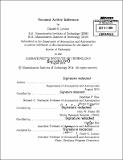Focused active inference
Author(s)
Levine, Daniel S., Ph. D. Massachusetts Institute of Technology
DownloadFull printable version (6.178Mb)
Other Contributors
Massachusetts Institute of Technology. Department of Aeronautics and Astronautics.
Advisor
Jonathan P. How.
Terms of use
Metadata
Show full item recordAbstract
In resource-constrained inferential settings, uncertainty can be efficiently minimized with respect to a resource budget by incorporating the most informative subset of observations - a problem known as active inference. Yet despite the myriad recent advances in both understanding and streamlining inference through probabilistic graphical models, which represent the structural sparsity of distributions, the propagation of information measures in these graphs is less well understood. Furthermore, active inference is an NP-hard problem, thus motivating investigation of bounds on the suboptimality of heuristic observation selectors. Prior work in active inference has considered only the unfocused problem, which assumes all latent states are of inferential interest. Often one learns a sparse, high-dimensional model from data and reuses that model for new queries that may arise. As any particular query involves only a subset of relevant latent states, this thesis explicitly considers the focused problem where irrelevant states are called nuisance variables. Marginalization of nuisances is potentially computationally expensive and induces a graph with less sparsity; observation selectors that treat nuisances as notionally relevant may fixate on reducing uncertainty in irrelevant dimensions. This thesis addresses two primary issues arising from the retention of nuisances in the problem and representing a gap in the existing observation selection literature. The interposition of nuisances between observations and relevant latent states necessitates the derivation of nonlocal information measures. This thesis presents propagation algorithms for nonlocal mutual information (MI) on universally embedded paths in Gaussian graphical models, as well as algorithms for estimating MI on Gaussian graphs with cycles via embedded substructures, engendering a significant computational improvement over existing linear algebraic methods. The presence of nuisances also undermines application of a technical diminishing returns condition called submodularity, which is typically used to bound the performance of greedy selection. This thesis introduces the concept of submodular relaxations, which can be used to generate online-computable performance bounds, and analyzes the class of optimal submodular relaxations providing the tightest such bounds.
Description
Thesis: Ph. D., Massachusetts Institute of Technology, Department of Aeronautics and Astronautics, 2014. Cataloged from PDF version of thesis. Includes bibliographical references (pages 91-99).
Date issued
2014Department
Massachusetts Institute of Technology. Department of Aeronautics and AstronauticsPublisher
Massachusetts Institute of Technology
Keywords
Aeronautics and Astronautics.